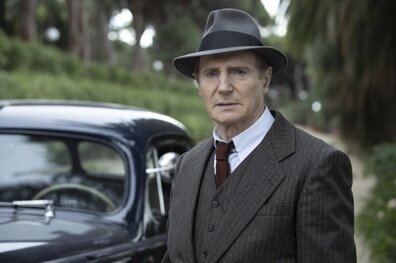
Marlowe
Studio: Storyboard Media
Director: Neil Jordan
Feb 16, 2023
Web Exclusive
![]()
Raymond Chandler’s legendary private detective Philip Marlowe must be one of the literary characters most frequently adapted for cinema. Despite Chandler only having written seven Marlowe novels, there have (not including this one) been 10 cinematic portrayals of the character, with the character being played by actors as varied and distinguished as Humphrey Bogart, Elliott Gould, and Robert Mitchum. The 11th and latest Marlowe film casts Liam Neeson as the central character and takes John Banville’s 2014 novel, The Black-Eyed Blonde (which was authorized by Chandler’s estate), as its basis, helmed by The Crying Game and Interview with the Vampire director Neil Jordan.
In this iteration, Liam Neeson stars as the title character, his biography having been retconned to make him an aging World War I veteran around his mid-fifties operating in Chandler’s fictitious Bay City district of Los Angeles in 1939. One day, beautiful heiress Clare Cavendish (Diane Kruger) enters his office to hire him to track down her former lover, Nico Peterson (François Arnaud), who has seemingly vanished into thin air. This sends Marlowe on a typically Chandlerian trail of false starts, dead ends, leads, and discoveries.
The film’s visuals are great, as any good neo-noir’s should be. Cinematographer Xavi Giménez does not make use of the chiaroscuro lighting utilized so memorably in classic Marlowe adaptations like The Big Sleep (Howard Hawks, 1946) and Murder, My Sweet (Edward Dmytryk, 1944). Whilst some film noir genre purists may take issue with this, Giménez does supplant this style with the same sort of high-key lighting that was used in notable 1990s neo-noirs like Devil in a Blue Dress (Carl Franklin, 1995) and LA Confidential (Curtis Hanson, 1997). It is used in a similar fashion to how it was in the latter two films; namely, it serves to showcase the stark contrast between the sunniness of the film’s location and the grittiness and seediness of the activities being depicted. Credit should also go to production designer John Beard and art director Mani Martínez for recreating the Spanish-influenced architecture of late 1930s Los Angeles faithfully and evocatively.
Neeson does a good job as Marlowe, although again, fans of the books and the classic adaptations thereof may have issues with his portrayal of the character. Whilst Chandler’s six-foot, 190 lb. Marlowe was a character who could handle himself in a combat situation, he mostly relied on his quick wit, gift of gab, and projection of quiet strength to get around the need for fisticuffs. As is to be expected given that this has become Neeson’s métier over the last 15 years, his Philip Marlowe punches, kicks, and shoots his way out of trouble, rather than talking his way out of it. In this sense, the larger Neeson’s interpretation of the character is more akin to that provided by the overtly hard Robert Mitchum in Farewell, My Lovely (Dick Richards, 1975) than those given by the physically unprepossessing Elliott Gould in The Long Goodbye (Robert Altman, 1973) and Humphrey Bogart in The Big Sleep.
Whilst the announcement of a new Philip Marlowe adaptation piqued my interest, I was fully prepared for it to be bad. I am therefore relieved to be able to report that Marlowe is an undeniably very enjoyable film. It may not be the most faithful cinematic iteration of the character we have been given, but I was thoroughly engrossed for the entirety of its 109-minute running time. The film’s plot can be hard to follow at times, and one gets the impression that if deconstructed it may well be found to be full of holes, but its atmosphere is so engagingly pulpy that any possible flaws in its narrative become non-issues.
Neeson may make for a tougher Marlowe than we’re used to seeing, but no less likeable a Marlowe, and the character’s implicit social liberalism should endear him to contemporary audiences. He is more than ably assisted in his acting work by strong supporting performances from the likes of Jessica Lange, Adewale Akinnuoye-Agbaje, Danny Huston, Ian Hart, Alan Cumming, and Colm Meaney. Additionally, the action sequences, whilst possibly having the potential to arouse the ire of Marlowe canon purists, are very entertaining. To sum up, Marlowe is great fun, and fans of the character, Neeson’s action roles, classic noir, and contemporary noir would be well-advised to check it out. (www.storyboardfilm.com)
Author rating: 8/10
Current Issue

Issue #72
Apr 19, 2024 Issue #72 - The ‘90s Issue with The Cardigans and Thurston Moore
Most Recent
- 10 Best Songs of the Week: Nilüfer Yanya, Linn Koch-Emmery, Fat Dog, Crumb, St. Vincent, and More (News) —
- Fat Dog Announce New Album and Tour, Share Video for New Song “Running” (News) —
- The Obsessed, Howling Giant @ Brooklyn Meadows, NYC, April 12, 2024 (Review) —
- Premiere: Slow Joy Releases New Single and Video for “King Cowboy” (News) —
- Premiere: Mackenzie Shrieve Shares New Single “Didn’t I Tell Ya” Feat. Jane Bruce (News) —

Comments
Submit your comment
There are no comments for this entry yet.